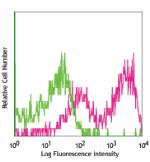- Clone
- OX-19 (See other available formats)
- Regulatory Status
- RUO
- Other Names
- Ly-1, Tp67, Leu-1, T1, Lyt-1
- Isotype
- Mouse IgG1, κ
- Ave. Rating
- Submit a Review
CD5 is a 67 kD glycoprotein, also known as Lyt-1, Ly-1 or Ly-12. It is a member of the scavenger receptor superfamily and primarily expressed on thymocytes and mature peripheral T lymphocytes, but not on NK cells, intestinal intraepithelial gamma/delta T cells. A CD5+ B cell subset (B-1) has not been characterized in that rat.
Product DetailsProduct Details
- Verified Reactivity
- Rat
- Antibody Type
- Monoclonal
- Host Species
- Mouse
- Immunogen
- Rat thymocyte lentil lectin-binding glycoproteins
- Formulation
- Phosphate-buffered solution, pH 7.2, containing 0.09% sodium azide.
- Preparation
- The antibody was purified by affinity chromatography.
- Concentration
- 0.5 mg/ml
- Storage & Handling
- The antibody solution should be stored undiluted between 2°C and 8°C.
- Application
-
FC - Quality tested
ICC - Reported in the literature, not verified in house - Recommended Usage
-
Each lot of this antibody is quality control tested by immunofluorescent staining with flow cytometric analysis. For flow cytometric staining, the suggested use of this reagent is ≤ 0.25 µg per 106 cells in 100 µl volume. It is recommended that the reagent be titrated for optimal performance for each application.
-
Application References
(PubMed link indicates BioLegend citation) -
- Dallman MJ, et al. 1984. Eur. J. Immunol. 14:260.
- Vemeer LA, et al. 1994. Eur. J. Immunol. 24:585.
- RRID
-
AB_1089042 (BioLegend Cat. No. 203501)
Antigen Details
- Structure
- CD5 is a 67 kD glycoprotein of scavenger receptor superfamily. It is expressed on thymocytes, T cells and small subset of B cells.
- Distribution
-
Expressed on thymocytes, peripheral T cells, and some thymic dendritic cells. It should be noted that a CD5+ subset of B cells has not been characterized in the rat by OX-19. Most gamma/delta T cells do not express CD5.
- Function
- Important in T-B cell interaction.
- Ligand/Receptor
- CD72
- Biology Area
- Immunology, Costimulatory Molecules
- Molecular Family
- CD Molecules, TCRs
- Antigen References
-
1. Vermeer LA, et al. 1994. Eur. J. Immunol. 24:585.
- Gene ID
- 54236 View all products for this Gene ID
- UniProt
- View information about CD5 on UniProt.org
Related FAQs
Other Formats
View All CD5 Reagents Request Custom Conjugation| Description | Clone | Applications |
|---|---|---|
| Purified anti-rat CD5 | OX-19 | FC,ICC |
Customers Also Purchased
Compare Data Across All Formats
This data display is provided for general comparisons between formats.
Your actual data may vary due to variations in samples, target cells, instruments and their settings, staining conditions, and other factors.
If you need assistance with selecting the best format contact our expert technical support team.
-
Purified anti-rat CD5

LOU rat splenocytes stained with OX-19 purified, followed by...

















Follow Us